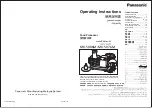
Digital Audio Transmitter
DAX Internal Architecture
MOTOROLA
DSP56012 User’s Manual
8-11
Note:
The XAUR bit is cleared by reading the XSTR register with XAUR set,
followed by writing data to XADRA and XADRB. It is also cleared by software
reset and hardware reset, and by the Stop state.
8.5.5.4
DAX Block Transfer Flag (XBLK)—Bit 3
The XBLK flag indicates that the frame being transmitted is the last frame in a block.
This bit is set at the beginning of the transmission of the last frame (the 191st frame).
This bit does not cause any interrupt. However, it causes a change in the interrupt
vector sent to DSP core in the event of an interrupt, so that a different interrupt
routine can be called (providing the next non-audio data structures for the next block
as well as storing audio data for the next frame). Writing to XADRA and XADRB
clears this bit.
Note:
Software reset, hardware reset, and the Stop state clear XBLK.
The relative timing of transmit frames and XADE and XBLK flags is shown in
Figure 8-3
on page 8-11.
8.5.5.5
DAX Transmit In Progress (XTIP)—Bit 4
The XTIP status flag indicates that the DAX is enabled and transmitting data. When
XTIP is set, it indicates that the DAX is active. When XTIP is cleared, it indicates that
the DAX is inactive. This bit provides programmers with the means to determine
whether the DAX is active or inactive. Since the DAX can be active and transmitting
data even after the XEN bit in the XCTR has been cleared (with XSTP = 1), it can be
necessary to know when the DAX actually becomes inactive. This bit is set a moment
after the DAX is enabled (XEN = 1). It is cleared either immediately (by clearing the
XEN bit, when XSTP = 0), or it is cleared at the next frame boundary (if XSTP = 1).
Note:
Software reset, hardware reset, and the Stop state clear XTIP immediately.
Figure 8-3 DAX Relative Timing
#000 #001
#008
#007
#006
#005
#004
#003
#002
#009 #010
#021
#011
#018
#017
#016
#015
#014
#013
#012
#019 #020
#022 #023
#024 #025
#032
#031
#030
#029
#028
#027
#026
#033 #034
#045
#035
#042
#041
#040
#039
#038
#037
#036
#043 #044
#046 #047
XADE
XBLK
Frame
XADE
XBLK
Frame
XADE
XBLK
Frame
#168 #169
#176
#175
#174
#173
#172
#171
#170
#177 #178
#189
#179
#186
#185
#184
#183
#182
#181
#180
#187 #188
#190 #191
AA0608
Summary of Contents for DSP56012
Page 12: ...xii Motorola ...
Page 20: ...xx Motorola ...
Page 21: ...MOTOROLA DSP56012 User s Manual 1 1 SECTION 1 OVERVIEW ...
Page 40: ...1 20 DSP56012 User s Manual MOTOROLA Overview DSP56012 Architectural Overview ...
Page 41: ...MOTOROLA DSP56012 User s Manual 2 1 SECTION 2 SIGNAL DESCRIPTIONS ...
Page 61: ...SECTION 3 MEMORY OPERATING MODES AND INTERRUPTS ...
Page 81: ...MOTOROLA DSP56012 User s Manual 4 1 SECTION 4 PARALLEL HOST INTERFACE ...
Page 148: ...4 68 DSP56012 User s Manual MOTOROLA Parallel Host Interface Host Interface HI ...
Page 149: ...MOTOROLA DSP56012 User s Manual 5 1 SECTION 5 SERIAL HOST INTERFACE ...
Page 179: ...MOTOROLA DSP56012 User s Manual 6 1 SECTION 6 SERIAL AUDIO INTERFACE ...
Page 205: ...MOTOROLA DSP56012 User s Manual 7 1 SECTION 7 GPIO ...
Page 210: ...7 6 DSP56012 User s Manual MOTOROLA GPIO GPIO Register GPIOR ...
Page 211: ...MOTOROLA DSP56012 User s Manual 8 1 SECTION 8 DIGITAL AUDIO TRANSMITTER ...
Page 226: ...8 16 DSP56012 User s Manual MOTOROLA Digital Audio Transmitter DAX Programming Considerations ...
Page 233: ...MOTOROLA DSP56012 User s Manual B 1 APPENDIX B PROGRAMMING REFERENCE ...
















































